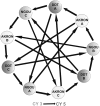Identification and validation of a gene causing cross-resistance between insecticide classes in Anopheles gambiae from Ghana
- PMID: 22460795
- PMCID: PMC3341073
- DOI: 10.1073/pnas.1203452109
Identification and validation of a gene causing cross-resistance between insecticide classes in Anopheles gambiae from Ghana
Abstract
In the last decade there have been marked reductions in malaria incidence in sub-Saharan Africa. Sustaining these reductions will rely upon insecticides to control the mosquito malaria vectors. We report that in the primary African malaria vector, Anopheles gambiae sensu stricto, a single enzyme, CYP6M2, confers resistance to two classes of insecticide. This is unique evidence in a disease vector of cross-resistance associated with a single metabolic gene that simultaneously reduces the efficacy of two of the four classes of insecticide routinely used for malaria control. The gene-expression profile of a highly DDT-resistant population of A. gambiae s.s. from Ghana was characterized using a unique whole-genome microarray. A number of genes were significantly overexpressed compared with two susceptible West African colonies, including genes from metabolic families previously linked to insecticide resistance. One of the most significantly overexpressed probe groups (false-discovery rate-adjusted P < 0.0001) belonged to the cytochrome P450 gene CYP6M2. This gene is associated with pyrethroid resistance in wild A. gambiae s.s. populations) and can metabolize both type I and type II pyrethroids in recombinant protein assays. Using in vitro assays we show that recombinant CYP6M2 is also capable of metabolizing the organochlorine insecticide DDT in the presence of solubilizing factor sodium cholate.
Conflict of interest statement
The authors declare no conflict of interest.
Figures



References
-
- Lengeler C. Insecticide-treated bed nets and curtains for preventing malaria. Cochrane Database Syst Rev. 2004;2:CD000363. - PubMed
-
- Corbett JR, Wright K, Baillie AC. The Biochemical Mode of Action of Pesticides. 2nd Ed. London: Academic Press; 1984. pp. 99–174.
-
- Vijverberg HPM, van der Zalm JM, van der Bercken J. Similar mode of action of pyrethroids and DDT on sodium channel gating in myelinated nerves. Nature. 1982;295:601–603. - PubMed
-
- Davies TGE, Field LM, Usherwood PNR, Williamson MS. DDT, pyrethrins, pyrethroids and insect sodium channels. IUBMB Life. 2007;59:151–162. - PubMed
Publication types
MeSH terms
Substances
Grants and funding
LinkOut - more resources
Full Text Sources
Other Literature Sources
Miscellaneous

